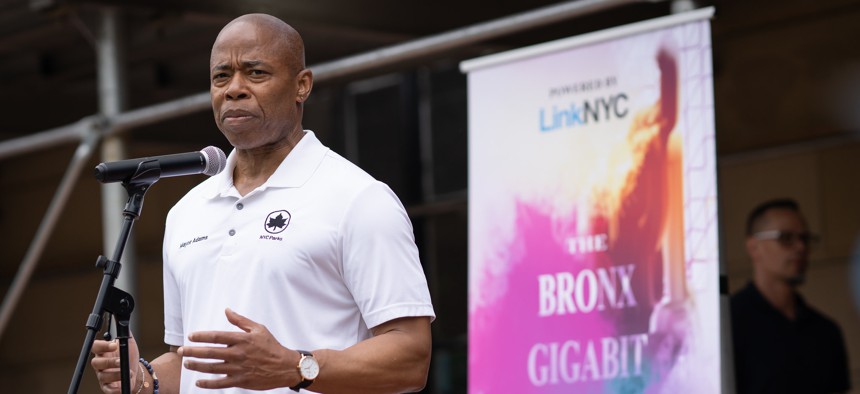New York City
Adams offers comprehensive affordable housing plan
The New York City mayor’s approach includes solutions for homelessness, promotes home ownership and improves support for NYCHA, but is short on metrics and numerical goals.

New York City Mayor Eric Adams unveiled a comprehensive affordable housing plan. Ed Reed/Mayoral Photography Office
When New York City Bill de Blasio took office in January 2014, there were 53,615 New Yorkers sleeping in city shelters. When he left office eight years later, there were 48,691 people sleeping in shelters, according to the Coalition for the Homeless. Many real New Yorkers found stable housing in that time, and each success story is a win for housing advocates, the de Blasio administration, and most of all the people moving out of shelter themselves. But the high number remaining proves its an issue that didn’t come close to getting fixed.
You could say the same thing looking at the New York City Housing Authority – some public housing tenants saw broken boilers replaced and moldy bathrooms renovated in de Blasio’s tenure, but the list of capital needs across the city’s developments remains enormous. And while tens of thousands of New Yorkers are happy in rent regulated apartments secured in the affordable housing lottery while de Blasio was in office, median rents in the city have reached record highs, and competition on the open market is cutthroat as ever, to landlords’ benefit.
Now, the new mayor is announcing his plan to take on those same problems, pitching a comprehensive approach to build more housing across the city and to get homeless and other low and middle income New Yorkers into it, to promote homeownership, and to renovate public housing.
Speaking on a rooftop in Downtown Brooklyn Tuesday, Mayor Eric Adams promised those who had been working in the housing field that “the cavalry is coming,” while acknowledging the difficulty of the task. “Huge undertaking. We’re clear on that. And we’re not always going to get it right,” Adams said. “We know we have so much to do. But one thing for sure – one thing we’re not going to fail at – we’re not going to fail at trying. We will succeed.”
Success may be hard to measure, though. Adams’ 97 page “Housing our Neighbors: a Blueprint for Housing and Homelessness”is short on metrics and numerical goals. That’s a point he freely conceded Tuesday, indirectly criticizing de Blasio for focusing too much on numbers, and less on the human element. What will be Adams’ goal for getting homeless New Yorkers into housing? “As many as possible,” he said.
Adams had previewed some of blueprints’ highlights before. Earlier in June, he talked about loosening zoning regulations to encourage the building of more housing. Adams again praised passage of a state law creating the NYCHA Preservation Trust, which is key to the mayor’s plan to renovate public housing. Adams also wants to create NYCHA Stat, based on the police’s COMP stat, to clearly track maintenance in public housing. Along with Chief Housing Officer Jessica Katz, the mayor also highlighted plans to better enforce unsafe housing conditions, to step up enforcement of landlords who refuse to accept housing vouchers and to create a more accurate census of the city’s homeless population. There’s a bill to do that before the City Council, but advocates say the administration’s plan there already falls short.
That’s the problem. It’s an ambitious plan, and advocates for tenants and the homeless like the Legal Aid Society praised it for removing bureaucratic red tape that can make it more difficult for low income New Yorkers to get housing.
But as always, advocates would like to see more funding. The budget the City Council passed Monday night includes Adams’ plan to devote $22 billion to building housing over ten years. At $2.2 billion annually, that’s a record amount, but far short of the mayor’s campaign commitment to devote $4 billion a year.
New Yorkers need access to “safe, long-term and affordable housing,” a statement from the Legal Aid Society read. “This is the only real solution to our city’s sprawling housing crisis, and we call on City Hall to continue to dedicate capital dollars to fund truly affordable housing development throughout the boroughs.”

